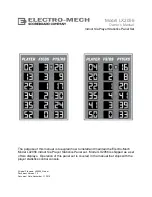
OPERATING INSTRUCTIONS
The monitor must be connected to a suitable DC power source and video signal. The
monitor will switch on as soon as the power is applied and a picture will be displayed.
Basic User Controls
Adjustments to the picture can be made by means of the push button controls on the front of
the monitor.
The
→
&
←
buttons control the contrast of the display. If either of these buttons is
pressed then the monitor displays a banner that shows the value of contrast. Further
pressing of the buttons will then adjust the contrast.
The
↑
&
↓
buttons control the video brightness of the display.. If either of these buttons is
pressed then the monitor dipslays a banner that shows the brightness. Further pressing of
the buttons will then adjust the brightness.
The two left hand buttons control the illumination of the display backlights.
These basic user controls are the only adjustemnts that can be made when the OSD lockout
function is enabled.
Advanced OSD Controls
Pressing menu button activates the monitor’s
main set-up controls. When this is done the
monitor displays a menu of adjustments. The
↑
&
↓
buttons allow selection of which item
to adjust. The
→
&
←
buttons adjust the
highlighted item.
OSD Information Banner
Information about the input signal is displayed at the bottom of the OSD. The values on the
left hand side are the Horizontal Rate (48.40kHz) and the Vertical Rate (59.8Hz).
On the right hand side the values are the active video size that the current video made is
based upon. This will be either in WHITE—indicating that the current scaling is based on
factory preset standard mode, or CYAN—indicating that the scaling has been calculated by
the monitor, either automatically or directed by the
Reset Modes
menu item. These values
do not change and are only for reference.
5
GETTING STARTED
GETTING STARTED
3
Section
3.1


































